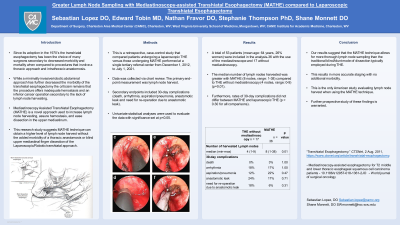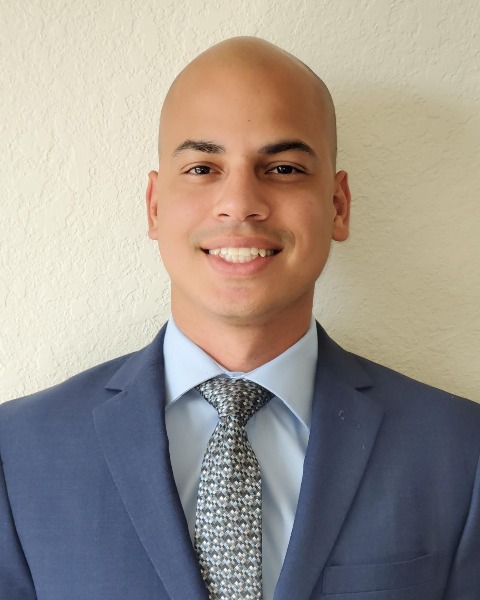Back

Thoracic
Category: Quickshot Oral Session 16
Quickshot Oral : Quickshot Oral Session 16
GREATER LYMPH NODE SAMPLING WITH MEDIASTINOSCOPY-ASSISTED TRANSHIATAL ESOPHAGECTOMY (MATHE) COMPARED TO LAPAROSCOPIC TRANSHIATAL ESOPHAGECTOMY
Monday, February 13, 2023
7:00am – 8:00am East Coast USA Time


Sebastian Lopez, DO
PGY 3
CAMC/WVU, United States- SM
Shane Monnett, DO, FACS
Assistant Professor
CAMC/WVU, United States
Presenter(s)
Principal Contact(s)
Objectives: Since its adoption in the 1970’s transhiatal esophagectomy has been the choice of many surgeons secondary to decreased morbidity and mortality compared to procedures that involve a thoracic approach and intrathoracic anastomosis. While a minimally invasive/robotic abdominal approach has further decreased the morbidity of the transhiatal esophagectomy the criticism remains that the procedure offers inadequate hemostasis and an inferior cancer operation secondary to the lack of lymph node harvesting. Mediastinoscopy Assisted Trahshiatal Esophagectomy (MATHE) is a novel approach used to increase lymph node harvesting, assure hemostasis, and ease dissection in the upper mediastinum. This research study suggests MATHE technique can obtain a high level of lymph node harvest without the added morbidity of a thoracic anastomosis or blind upper mediastinal finger dissection of the more traditional laparoscopic/robotic transhiatal approach.
Methods: This is a retrospective, case-control study that compared patients undergoing a laparoscopic THE versus those undergoing MATHE performed at a single tertiary referral center from December 1, 2012, to July 1, 2021. Data was collected via chart review. The primary end-point measurement was lymph node harvest. Secondary endpoints included 30-day complications (death, arrhythmia, aspiration/pneumonia, anastomotic leak and need for re-operation due to anastomotic leak). Univariate statistical analyses were used to evaluate the data with significance set at p< 0.05.
Results: A total of 53 patients (mean age: 64 years, 26% women) were included in the analysis-36 with the use of the mediastinoscope and 17 without mediastinoscopy. The median number of lymph nodes harvested was greater with MATHE (8 nodes, range: 1-38) compared to THE without mediastinoscopy (4 nodes, range: 0-9) (p=0.01). Furthermore, rates of 30-day complications did not differ between MATHE and laparoscopic THE (p > 0.30 for all comparisons).
Conclusion: Our results suggest that the MATHE technique allows for more thorough lymph node sampling than the traditional blind/blunt mode of dissection typically employed during THE. This results in more accurate staging with no additional morbidity. This is the only American study evaluating lymph node harvest when using the MATHE technique. Further prospective study of these findings is warranted.
Methods: This is a retrospective, case-control study that compared patients undergoing a laparoscopic THE versus those undergoing MATHE performed at a single tertiary referral center from December 1, 2012, to July 1, 2021. Data was collected via chart review. The primary end-point measurement was lymph node harvest. Secondary endpoints included 30-day complications (death, arrhythmia, aspiration/pneumonia, anastomotic leak and need for re-operation due to anastomotic leak). Univariate statistical analyses were used to evaluate the data with significance set at p< 0.05.
Results: A total of 53 patients (mean age: 64 years, 26% women) were included in the analysis-36 with the use of the mediastinoscope and 17 without mediastinoscopy. The median number of lymph nodes harvested was greater with MATHE (8 nodes, range: 1-38) compared to THE without mediastinoscopy (4 nodes, range: 0-9) (p=0.01). Furthermore, rates of 30-day complications did not differ between MATHE and laparoscopic THE (p > 0.30 for all comparisons).
Conclusion: Our results suggest that the MATHE technique allows for more thorough lymph node sampling than the traditional blind/blunt mode of dissection typically employed during THE. This results in more accurate staging with no additional morbidity. This is the only American study evaluating lymph node harvest when using the MATHE technique. Further prospective study of these findings is warranted.

